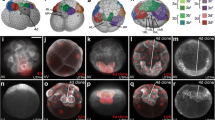Abstract
This paper is devoted to the role of cell divisions for the establishment of histospecificity in the embryo of the spiralian, Platynereis dumerilii (Annelida). We have incubated successive cleavage stages in cytochalasin B (CCB) and observed whether the cells thereafter were able to acquire the competence for expressing histospecific antigens of larval gland cells (labelled by the monoclonal antibody OI64) and of neural components of the ventral nerve cord (labelled by mAb OI7 or by testing acety1cholinesterase activity), respectively. Incubation in CCB results in permanent cleavage arrest, but does not necessarily interfere with biochemical differentiation of such markers. Synthesis of the differentiation marker specific for larval gland cells does not require any cleavages but this capacity becomes restricted to the 1a and 1b cell lines if cleavages are allowed to occur. In contrast, the progenitors of neural cells need at least 6.5 h of normal development before they acquire the competence to synthesize two neural differentiation markers, which can be demonstrated after at least two more days of development. Thus, prespecifying and diversifying cleavages are a prerequisite for neurogenesis and production of the investigated neural markers. Competence for the expression of histospecific antigens may also depend on cell-cell interactions. If 20–24 h old embryos are treated with puromycin, pioneering fibres fail to grow out from a pair of posterior nerve cell progenitors as they would have done normally 24–48 h after fertilization. Concomitantly, a number of potential nerve cells which now do not come into contact with pioneering fibres do not express the neural antigen. This suggests that a local inductive stimulus from the pioneering fibres normally imprints cell fate onto ventral plate cells and turns them into neuroblasts.
Similar content being viewed by others
References
Bastiani MJ, Harrelson AL, Snow PM, Goodman CS (1987) Expression of fasciclin I and II glycoproteins on subsets of axon pathways during neuronal development in the grasshopper. Cell 48:745–755
Costello DP (1945) Experimental studies of germinal localization in Nereis. I. The development of isolated blastomeres. J Exp Zool 100:19–66
Deno T, Satoh N (1984) Studies on the cytoplasmic determinant for muscle cell differentiation in ascidian embryos: An attempt at transplantation of the myoplasm. Dev Growth Diff 26:43–88
Dorresteijn AWC (1990) Quantitative analysis of cellular differentiation during early embryogenesis of Platynereis dumerilii. Roux's Arch Dev Biol 199:14–30
Dorresteijn AWC, Eich P (1991) Experimental change of cytoplasmic composition can convert determination of blastomeres in Platynereis dumerilii (Annelida, Polychaeta). Roux's Arch Dev Biol 200:342–351
Dorresteijn AWC, O'Grady B, Fischer A, Porchet-Henneré E, Boilly-Marer Y, (1993) Molecular specification of cell lines in the embryo of Platynereis (Annelida). Roux's Arch Dev Biol 202:264–273
Freeman G (1979) The multiple roles which cell division can play in the localization of developmental potential. In: Subtelny S, Konigsberg IR (eds) Determinants of spatial organization. Academic Press, New York, pp 53–76
Hauenschild C, Fischer A (1969) Platynereis dumerilii. Mikroskopische Anatomie, Fortpflanzung, Entwicklung. (Großes Zoologisches Praktikum, Heft 10b) Gustav Fischer, Stuttgart, pp 1–55
Karnovsky MJ, Roots L (1964) A “direct-coloring” thiocholine method for cholinesterases. J Histochem Cytochem 12:219–221
Priess RA, Thomson JN (1987) Cellular interactions in early C. elegans embryos. Cell 48:241–250
Satoh N, Ikegami S (1981) A definite number of aphidicolin-sensitive cell-cycle events are required for acetylcholinesterase development in the presumptive muscle cells of the ascidian embryos. J Embryol Exp Morphol 61:1–13
Schneider S, Fischer A, Dorresteijn AWC (1992) A morphometric comparison of dissimilar early development in sibling species of Platynereis (Annelida, Polychaeta). Roux's Arch Dev Biol 201:243–256
Whittaker JR (1973) Segregation during ascidian embryogenesis of egg cytoplasmic information for tissue-specific enzyme development. Proc Nat Acad Sci USA 70:2096–2100
Wilson EB (1904) Experimental studies on germinal localization. II. Experiments on the cleavage-mosaic in Patella and Dentalium. J Exp Zool 1:197–268
Author information
Authors and Affiliations
Additional information
Correspondence to: A.W.C. Dorresteijn
Rights and permissions
About this article
Cite this article
Dorresteijn, A.W.C., Graffy, C. Competence of blastomeres for the expression of molecular tissue markers is acquired by diverse mechanisms in the embryo of Platynereis (Annelida). Roux's Arch Dev Biol 202, 270–275 (1993). https://doi.org/10.1007/BF00363216
Received:
Accepted:
Issue Date:
DOI: https://doi.org/10.1007/BF00363216




